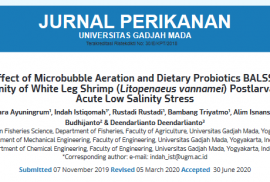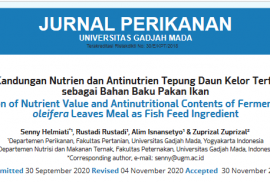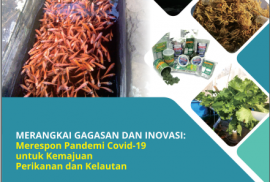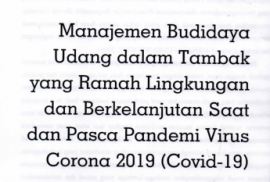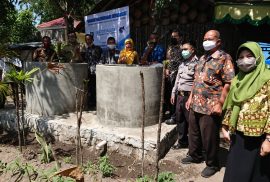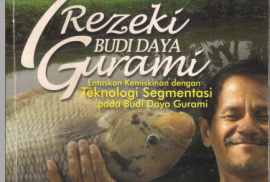| Judul/Title | Protective Effect of Microbubble Aeration and Dietary Probiotics BALSS on Survival and Immunity of White Leg Shrimp (Litopenaeus vannamei) Postlarvae against Acute Low Salinity Stress |
| Penulis/Author | Indah Istiqomah, S.Pi., M.Si., Ph.D (2) ; Prof. Dr. Ir. Rustadi, M.Sc. (3); Dr. Ir. Bambang Triyatmo, M.P. (4); Dr. Ir. Alim Isnansetyo, M.Sc. (5); Wiratni, S.T., M.T., Ph.D. (6); Dr. Deendarlianto, S.T., M.Eng. (7) |
| Tanggal/Date | 30 2020 |
| Abstrak/Abstract | Survival rate and immunity of white leg shrimp (Litopenaeus vannamei) postlarvae against acute salinity stress were evaluated in indoor experimental trials. The research was conducted with 2×2 factorial design with two levels of aeration (microbubble and macro bubble) and two levels of diet (with and without probiotics) resulting four treatments in triplicate: application of microbubble with gut probiotics (MiP), without gut probiotics (MiC), and macro bubble with gut probiotics (MaP) and without probiotics (MaC). White leg shrimps measuring 7.6 g were maintained in the tanks for 60 days and fed five times a day at a dose of 5% biomass. Harvested shrimp were tested for low salinity stress (5 ppt) for 3 hours. Glucose level, total protein, bactericidal activity, natural agglutination, phenoloxidase, respiratory burst, and superoxide dismutase activities in the hemolymph and the shrimp survival rate (SR) were analyzed before and after the stress tests. Although all examined parameters remained the same between groups before the stress test, significant differences were found among them after the stress test. Microbubble aeration obtained stabilization of hemolymph glucose level, best survival rate, bactericidal activity, and agglutination activities. No significant effect was resulted by the dietary probiotic treatments, but the interaction with aeration treatments revealed the importance to compensate shrimp survival rate when microbubble aeration is unavailable. |
| Judul/Title | An Evaluation of Nutrient Value and Antinutritional Contents of Fermented Moringa oleifera Leaves Meal as Fish Feed Ingredient |
| Penulis/Author | Dr. Senny Helmiati, S.Pi., M.Sc. (1) ; Prof. Dr. Ir. Rustadi, M.Sc. (2); Dr. Ir. Alim Isnansetyo, M.Sc. (3); Prof. Dr. Ir. Zuprizal, DEA. (4) |
| Tanggal/Date | 30 2020 |
| Abstrak/Abstract | The aim of the study was to evaluate nutritive value and antinutritional contents of fermented Moringaoleifera leaves meal as a plant-based protein source as an alternative ingredient for aquafeed. The research stages included processing of M. oleifera leaf meal, preparation and calculation of bacterial density, fermentation process, and analysis of nutrient and antinutrient content. The bacteria used for fermentation is a mixture of T2A (Bacillus sp.), T3P1 (Bacillus sp.) and JAL11 (Lactococcus raffinolactis) bacteria with a density of 2.16×109 cfu/mL. Fermented M. oleifera leaves meal was carried out for 168 hours. Analysis of nutrient content and antinutrient substances of fermented M. oleifera leaves meal was carried out at 24, 48, 72, 96, 120, 144 and 168 hours. The nutrient content of Moringa leaf meal includes moisture (9.04±0.00%), ash (9.70±0.21%), protein (25.77±0.08%), fat (4.80± 0.52%), crude fiber (11.60±0.13%), extract material without nitrogen (39.06±0.52%), energy (351.27±3.27 kcal/100 g), hemicellulose (13.79±0.07%), cellulose (9.9±0.06%) and lignin (15.34±0.31%). Fermentation can increase moisture, ash, protein and fat content, and reduce crude fiber content, nitrogen free extract, hemicellulose, cellulose, lignin and antinutrients, including phenols, tannins, phytic acid and HCN. The results of the present study show that fermentation is able to improve nutrient dan decrease antinutritional content of M. oleifera leaves meal as a plant-based protein source for further use in aquafeed ingredient. |
| Judul/Title | Buku Putih Universitas Gadjah Mada: Gagasan Bulaksumur Membangun Kedaulatan Pangan Nusantara Inspirasi UGM untuk Indonesia |
| Penulis/Author | Dr. Jamhari, S.P., M.P. (1); Prof. Dr. Ir. Umar Santoso, M.Sc. (2); R. Ahmad Romadhoni Surya Putra, S.Pt., M.Sc., Ph.D. (3); Prof. Dr. Ir. Rustadi, M.Sc. (4); Subejo, S.P., M.Sc., Ph.D. (5); Agus Dwi Nugroho, S.P., M.Sc. (6); Mesalia Kriska, S.P., M.Sc. (7); Arif Wahyu Widada, S.P., M.Sc. (8); Muslimin, S.P., M.P. (9) |
| Tanggal/Date | 2019 |
[embeddoc url=”https://akua.faperta.ugm.ac.id/wp-content/uploads/sites/16/2021/08/buku-putih-ugmpdf.pdf”]
| Judul/Title | MERANGKAI GAGASAN DAN INOVASI: Merespon Pandemi Covid-19 untuk Kemajuan Perikanan dan Kelautan |
| Editor | Dr. Ir. Alim Isnansetyo, M.Sc.
Dr. Amir Husni, S.Pi., M.P. Dr. Eko Setyobudi, S.Pi., M.Si. Dr. Ratih Ida Adharini, S.Pi., M.Si. Mgs. Muhammad Prima Putra, S.Pi., M.Sc., Ph.D. |
| Tanggal/Date | 2020 |
[embeddoc url=”https://akua.faperta.ugm.ac.id/wp-content/uploads/sites/16/2021/08/merangkai-gagasan-dan-inovasi-dari-pandemi-covid-previewpdf.pdf”]
| Judul/Title | Manajemen Budidaya Udang dalam Tambak yang Ramah Lingkungan dan Berkelanjutan saat dan Pasca Pandemi Virus Corona 2019 (covid-19) |
| Penulis/Author | Dr. Ir. Bambang Triyatmo, M.P. (1) |
| Tanggal/Date | 10 2020 |
[embeddoc url=”https://akua.faperta.ugm.ac.id/wp-content/uploads/sites/16/2021/08/2020-des-udangtambak-covid-19-43sd66pdf.pdf”]
The Aquaculture Festival 2020 Scientific Writing Competition with the theme “Student Innovation in Increasing Aquaculture Productivity Based on Sustainable Aquaculture.” This competition was organized by the Bogor Agricultural Institute on 10-11 October 2020 online via the zoom application. The sub-themes that are followed are production systems and aquaculture technology. The participants who competed in this competition amounted to 22 teams from universities throughout Indonesia. Each team consists of 2-3 people, provided that all team members must come from the same college. The reason we are joining this competition is because the field sees problems in the fishing sector, which still has many obstacles. So it is hoped that this activity will be able to become a forum for developing innovations in the field of aquaculture to solve existing problems.
https://youtu.be/PLnRaJR2mTA
Pandemic community service activity (PKM) is a collaboration between Aquaculture Study Program and the Marine and Fisheries Division of Bantul Regency. The exploration of this collaboration started by both parties in March 2020. In the long term, this PKM aims to create an area-based fish farming center in Bantul Regency. Based on the results of a survey conducted during June-july 2020 and an assessment of the indicators of success, it was determined that a fish farming center would be developed sustainably at Mina Dompon Sejahtera Pokdakan (MDS). MDS, which was established in 2019, is a beginner class Pokdakan and is located in Kadisoro Hamlet, Gilangharjo Village, Pandak District (Figure 1). Currently, Pokdakan MDS manages 90 ponds built on 5,100 m2 of village treasury land. The commodities developed are catfish, gourami, and ornamental fish. In the short term, coinciding with the Covid-19 pandemic in 2020, this PKM aims to strengthen the on-farm performance of Pokdakan MDS through: (1) distribution of production facility stimulants in the form of fish feed, which functions as an asset as well as “revolving capital”; and (2) training in management and technical cultivation.
Community Development in Dusun Kandang Sari Nganglik Sleman: Catfish Cultivation in Buis Beton
Lecturers of Fisheries UGM have collaborated with the people of Dusun Kandang Sari, Sukoharjo, Ngaglik, Sleman to cultivate catfish. Cultivation of catfish is carried out in concrete buis tubs, which are generally only used for making wells. The advantage of using concrete buis is that fish farming can be done in a narrow area. In addition, another advantage is the cost of manufacturing is cheaper than making an earthen pond or a permanent pond.
| Judul/Title | 7 Rezeki Budidaya gurami, Teknologi Segmentasi |
| Penulis/Author | Dr. Ir. Ignatius Hardaningsih, M.Si. (2) ; Dr. Ir. Murwantoko, M.Si. (2); Dr. Senny Helmiati, S.Pi., M.Sc. (3) |
| Tanggal/Date | 1 2012 |
[embeddoc url=”https://akua.faperta.ugm.ac.id/wp-content/uploads/sites/16/2021/08/cover-bukupdf.pdf-gurami.pdf”]

